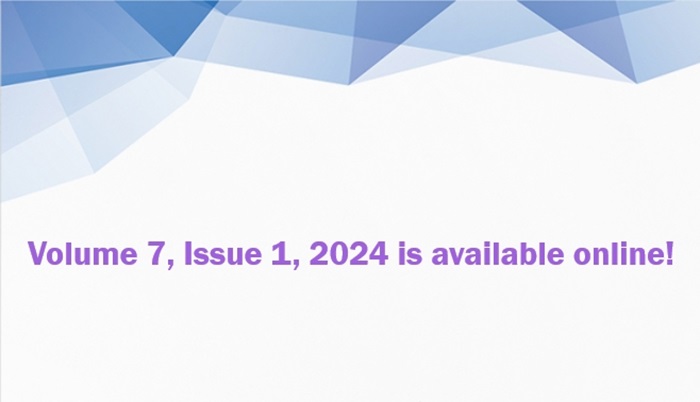2578-1960 (Online) Journal Abbreviation: Financ. Stat. J. | Financial Statistical Journal is an international Open Access journal that publishes original research articles and review articles related to all areas of financial statistics. The topics of interest include application of statistical techniques, data analysis, econometrics, mathematical methods, simulation and computation that related to finance. |
Online Submissions
Registration and login are required to submit items online and to check the status of current submissions.
Already have a Username/Password for Financial Statistical Journal?
GO TO LOGIN
Need a Username/Password?
GO TO REGISTRATION
Submission Preparation Checklist
As part of the submission process, authors are required to check off their submission's compliance with all of the following items, and submissions may be returned to authors that do not adhere to these guidelines.
- The submission has not been previously published, nor is it under the consideration of another journal (or an explanation has been provided in Comments to the Editor).
- The submission file is Microsoft Word file format.
- Where available, URLs for the references have been provided.
- The text adheres to the stylistic and bibliographic requirements outlined in the Author Guidelines, which is found in About the Journal.
- If submitting to a peer-reviewed section of the journal, the instructions in Ensuring a Blind Review have been followed.
Privacy Statement
EnPress Publisher respects and strives to protect the privacy of its users and visitors. Hence, users and visitors are encouraged to read EnPress Publisher’s privacy policy regarding the usage and handling of user information.
(1) User information
Names and email addresses entered in all EnPress Publisher’s journal sites will be used exclusively for the stated purposes of the journals and will not be made available for any other purpose or to any other party. For submission and peer review, users should register an account for further procedures, including but not limited to name, email, address, interests, affiliation, and postcode, as editors need the information to complete in-house processes (e.g., processing a manuscript).
When users visit the publisher's website, information about the visit is saved in web logs (e.g., device, IP address, time of visit, etc.), which are only used to help improve the structure and content of the website.
(2) User rights
Users have the right to register or update their personal information and contact the publisher to cancel/delete their account if required.
(3) Third-party link
EnPress Publisher is not responsible for private information obtained by third-party websites when users log in via a pop-up screen from third-party software installed on their computer.
When users visit third-party platforms (e.g., LinkedIn, Twitter, COPE, etc.) through hyperlinks from EnPress Publisher’s journal websites, the privacy policy follows the policies of the third-party platforms.
(4) Queries or contact
For any queries about EnPress Publisher’s privacy policy, please contact the editorial office at editorial@enpress-publisher.com.
Article Processing Charges (APCs)
Financial Statistical Journal is an Open Access Journal under EnPress Publisher. All articles published in Financial Statistical Journal are accessible electronically from the journal website without commencing any kind of payment. In order to ensure contents are freely available and maintain publishing quality, Article Process Charges (APCs) are applicable to all authors who wish to submit their articles to the journal to cover the cost incurred in processing the manuscripts. Such cost will cover the peer-review, copyediting, typesetting, publishing, content depositing and archiving processes. Those charges are applicable only to authors who have their manuscript successfully accepted after peer-review.
| Journal Title | APC |
|---|---|
| Financial Statistical Journal | $500 |
We encourage authors to publish their papers with us and don’t wish the cost of article processing fees to be a barrier especially to authors from the low and lower middle income countries/regions. A range of discounts or waivers are offered to authors who are unable to pay our publication processing fees. Authors can write in to apply for a waiver and requests will be considered on a case-by-case basis.
*Article No. is mandatory for payment and it can be found on the acceptance letter issued by the Editorial Office. Payment without indicating Article No. will result in processing problem and delay in article processing. Please note that payments will be processed in USD. You can make payment through Masters, Visa or UnionPay card.
Vol 8, No 1 (2025)
Table of Contents
Climate change has led to a rise in both the frequency and intensity of extreme weather events, presenting substantial challenges to the global property insurance sector. This study examines the concurrent crises faced by insurance companies in maintaining profitability and by property owners in affording coverage, thereby necessitating a reevaluation of current insurance paradigms. We present an innovative approach that utilizes a back-propagation (BP) neural network to forecast insurance losses and guide strategic underwriting decisions in regions prone to perils. Our advanced model combines crucial factors such as the likelihood of extreme meteorological phenomena, insurance risk premiums, and capital adequacy ratios to predict impending losses and inform insurance policy formulation. Through an extensive analysis of nearly two decades of catastrophe data from the United States and New Zealand, we determine the model’s effectiveness in anticipating insurance-related losses and providing strategic guidance to insurance entities. The study concludes with recommendations for insurers to enhance risk assessment, innovate products, collaborate with governments, invest in green projects, and establish dedicated climate risk management teams. The study contributes to the discourse on climate change adaptation in the insurance industry and offers practical solutions for navigating the complexities of extreme weather risk.
The implications of insurance risk margins for insurers are extensive, impacting their competitive position, financial stability, and overall business strategy. Inadequate risk margins can lead to significant financial losses and regulatory sanctions, endangering their reputation and long-term viability. This study examines the insurance claims for general accident and subsidized agriculture business classes of the Nigerian Agricultural Insurance Corporation (NAIC) from 2007 to 2019. The chain ladder technique is employed to estimate ultimate claims. By incorporating claims variability using the Mack model, we estimate a more appropriate risk margin for outstanding claims. Additionally, we frame the allocation of outstanding claims as an optimization problem and compute the optimal reserves for each accident year, constrained by 90% of the insurer’s overall budget, assuming log-normally distributed claims. Our findings indicate that although the total ultimate reserves for the general accident class is much lower than that of the subsidized agriculture, the former’s aggregated coefficient of variation for all accident years combined is much higher, with a value greater than one. This suggests that NAIC’s general accident class of business is highly susceptible to systemic risk contagion. Moreover, a significant underestimation of the risk margin is observed when variability analysis is not considered. Consequently, Nigerian insurance regulators are urged to mandate variability analysis in the claims reserve estimation within annual financial reports.
This study uses spatial-gravity models to examine intra-industry trade flow based on technological intensity for a cluster of the main EU-advanced economies (Spain, France, Germany, Italy, and Greece) and MEDA-transitional economies (Morocco, Algeria, Tunisia, Libya, Egypt, Israel, Jordan, Lebanon, Syria, and Turkey) from 1990 to 2020. We have inserted into the models in an original way the variables of cultural affinity to grasp the effects of the liability of foreignness. We also consider the upheavals began with the “global economic crisis” (2007–2008), including the “sovereign debt crisis” for EU countries (2009–2011), and the “Arab Springs” for MEDA-transitional economies (2011–012). Results show the SAR-AR specification used to estimate our models is correct, and variables to catch the liability of foreignness make for more suitable regression. We have found significant trade flows with one order of lags, as a proxy for a persistence effect in trade flows, as well as other explanatory variables such as industry middle productivity, openness, stock market capitalization, and the exchange rate. While tariff barriers, remittance in- and outflows, and dummy variables that capture the effect of partnership agreements and the upheavals are less significant, nonetheless, these two effects have been found to be significant in the low-tech and service industries. We also found that improvements in the governance climate in EU-advanced economies have a negative effect on intra-industry trade flow, whereas improvements in the governance climate in MEDA-transitional economies have a positive effect, but only for high-tech production and services. We conclude that it is important for the European Union to have traced new guidelines to Euro-Mediterranean (Euro-Med) common action through cooperation in order to avoid the deterioration of political and economic relations between the countries in the Euro-Med region.
This study assesses the performance of Small Finance Banks in India, focusing on their efficiency in the post-COVID-19 period from 2019 to 2023. It explores the influence of bank-specific and macroeconomic factors on the efficiency of Small Finance Banks, with the aim of understanding their role in promoting financial inclusion. The research employs a two-stage Data Envelopment Analysis (DEA) framework to evaluate the efficiency of 10 selected Small Finance Banks. It incorporates both bank-specific variables (such as capital adequacy ratio, credit-deposit ratio, and liquidity ratio) and macroeconomic factors (GDP and inflation) in a Tobit regression model to analyze their influence on efficiency. The study reveals that the majority of Small Finance Banks remained resilient during the pandemic, consistently achieving high efficiency scores, except for a slight dip in 2020–2021 due to lockdown measures. Bank-specific factors indicate a converse association between capital adequacy ratio and efficiency, while liquidity ratio and credit-deposit ratio positively correlate with efficiency. Macro factors, including GDP and inflation, have minimal impact on Small Finance Banks efficiency. This study provides a comprehensive assessment of Small Finance Banks’ performance post-COVID-19, shedding light on the factors influencing their efficiency. It offers valuable insights for policymakers and Small Finance Banks to strengthen their role in advancing financial inclusion in India, contributing to a more inclusive and dynamic financial landscape. The findings suggest that Small Finance Banks should focus on expanding their influence in niche segments by increasing assets, deposits, and revenue streams while managing operating expenses and liquidity risks. Listing on the stock exchange and active policy support for research initiatives can enhance the Small Finance Banks ecosystem and drive financial inclusion.
Announcements
Online Access to the articles of Vol.7, No.1, 2024 |
|
 We are pleased to announce that all the articles on vol. 7, No. 1, 2024, are now accessible online. This comprehensive collection is ready for your reading and research needs. |
|
| Posted: 2024-07-08 | |
Polish Quality Award for prof. Radosław Wolniak |
|
 |
|
| Posted: 2024-05-08 | More... |
Blockchain Technology: A Financial Game Changer |
|
 |
|
| Posted: 2024-01-10 | More... |
| More Announcements... |




 Open Access
Open Access
